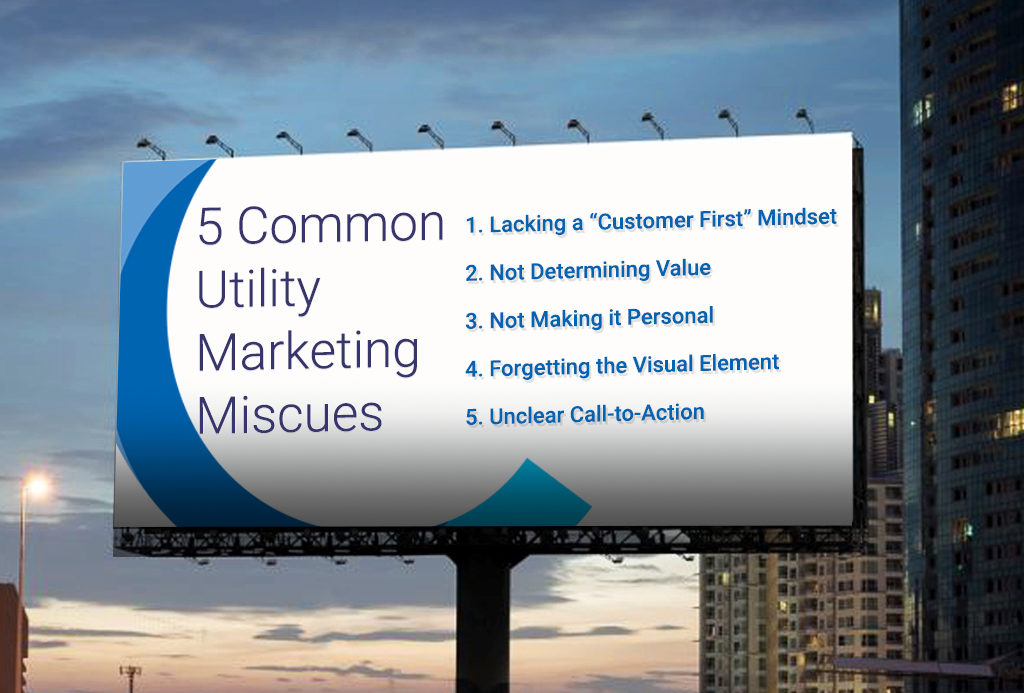5 Common Utility Program Marketing Miscues
A Perspective on Assessing Marketing Effectiveness
It’s no question that today’s consumers have become desensitized by the volume of advertising they receive. A 2017 study from the American Marketing Association estimates that the average consumer is exposed to up to 10,000 brand messages a day — that’s double the 5,000 daily ads or brand messages they were exposed to just 10 years ago.
If you are a marketer or implementer trying to drive program participation, a utility program manager working to achieve your annual goals, or even an evaluation director charged with determining return on investment, the question becomes, “How do you compete with the noise to achieve your business objectives?” The answer: ensuring that your marketing is working effectively.
Cadmus has been helping its utility clients assess their marketing effectiveness since 2001. Our approach is designed to help clients maximize their return on investment from marketing and customer engagement initiatives to the greatest extent possible. How do we do this? By focusing on the following:
- Strategy: a marketing plan can only be as successful as the strategy that guides its execution. Poor strategy means missed opportunities.
- Tactics: an organization interfaces with its customers through its marketing tactics. How effective tactics are in their design (creative), deployment (media), and ability to move targeted customers to action (engagement) makes or breaks marketing initiatives.
- Outcomes: the right performance metrics indicate the success of your marketing efforts. Whether they are quantitative or qualitative, outcomes help determine customer resonance and the ultimate impact of marketing and customer engagement initiatives.
What are some of the top miscues we see from our work? There are five common, yet avoidable mistakes we come across in our examination of utility program marketing.

Mistake #1: Lacking a “customer first” mindset.
All too often, elements that improve the customer experience, such as situational relevance and coordinated execution, are overlooked. For example, tactics that lack seasonal relevance may not appeal to the intended audience even when they are primed to take action. Another common occurrence is for multiple agencies marketing a utility’s programs to overload the marketing calendar and not coordinate their efforts, which only confuses customers.
Mistake #2: What’s the value?
Another major marketing crime is when a product or service lacks a clear value proposition. Over half the marketing we assess has lacked a strong value proposition – the reason why the customer should value the program (and thereby take the time to participate). A strong value proposition is the foundation for any messaging hierarchy constructed to drive action.
Mistake #3: Not making it personal.
According to Martech Today, by 2020 customer experience will overtake price and product as the key brand differentiator. The program marketing we have reviewed often lacks the personalization necessary to provide customers with the experience they are used to from engaging with other brands. Customers need to feel a connection to the brand, and that needs to start with messaging that is personalized and caters to their interests.
Mistake #4: Forgetting the visual element.
People respond to visuals – they draw the customer in to engage with the material. Just think about the world of social media: Facebook posts with images receive 230% more engagement than those without one. Some utility program marketing tactics lack sufficient or authentic (please don’t use stock images) visual content across many delivery channels such as print, digital, out-of-home, and social media.
Mistake #5: Customers don’t understand what you are asking them to do.
The last common mistake we find is the most concerning: after all that effort in crafting and delivering marketing materials, insights from half of the utility marketing we reviewed indicates that customers are often confused about how to participate or what the next step in the process is. Making the call-to-action as clear as possible is critical; it’s essential to tell your customers what you want them to do.
There’s a lot to think about when it comes to designing and deploying a successful marketing campaign or initiative. Cadmus’ marketing evaluation experts can help you determine how effective your current marketing efforts are and how they can be improved in the future. Contact us for a free materials review or social media audit and let us help you determine how you can improve your offerings today.
What’s next?
We know firsthand that there’s a lot think about when it comes to designing and deploying a successful marketing campaign or initiative – we are marketers ourselves. Cadmus gauges marketing effectiveness by combining its practicing digital and creative marketing professionals with its objective evaluation and research experts. Our team can help you identify and avoid these common utility program marketing miscues.